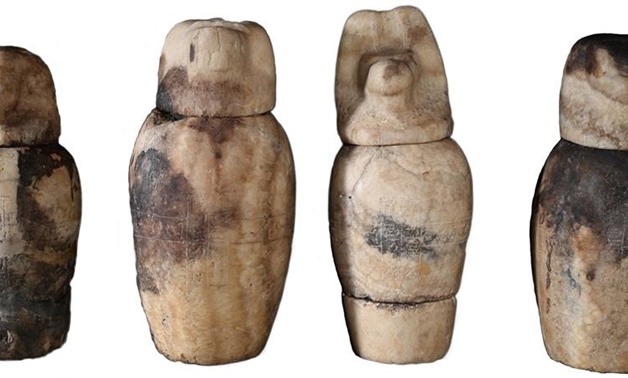
A well-preserved set of canopic jars was discovered in the tomb of Karabasken (TT 391), in the South Asasif Necropolis on the West Bank of Luxor - Ministry of Antiquities Official Facebook Page.
CAIRO – 25 June 2018: A well-preserved set of canopic jars was discovered in the tomb of Karabasken (TT 391), in the South Asasif Necropolis on the West Bank of Luxor by the Egyptian- American mission of South Asasif Conservation Project, working under the auspices of the Ministry of Antiquities.
The new discovery was announced by Mostafa Waziri, general secretary of the Supreme Council of Antiquities; Fathy Yassin, head of the Egyptian side of the mission, explained that the uncovered jars are made of Egyptian alabaster and probably held viscera.
As a result of the pressure of flood water the jars had fallen over and one of them was broken into several fragments. They underwent emergency cleaning and consolidation performed by the conservation team. Although the contents of the jars were damaged by floodwater, the jars still contained a large amount of resin. The sizes of the jars (with lids) vary from 35.5 to 39.4 cm. The lids depict a human, a baboon, a jackal and a falcon and are skillfully carved and modeled by three different artists.
Waziri pointed out that the canopic jars were found in a nearly cubic cutting in the floor in an intrusive burial compartment cut into the south wall of the Pillared Hall in the Kushite tomb of Karabasken (TT 391).
On her part Elena Pischikova, director of the South Asasif Conservation Project, said that the jars are belong to the "Lady of the House Amenirdis" from the 26th Dynasty.
The South Asasif Conservation project was founded in 2006 with the aim of restoring and reconstructing the damaged and partially collapsed Late Period tombs of the South Asasif necropolis, Karabasaken (TT 391), Karakhamun (TT 223) and Irtieru (TT 390). During its 12 years of work, the Project found thousands of fragments of the collapsed decoration of the tombs and reconstructed the Second Pillared Hall and part of the First Pillared Hall in the tomb of Karakhamun. The restored tombs will feature sophisticated carvings and paintings of the 25th and 26th dynasties.
 A well-preserved set of canopic jars was discovered in the tomb of Karabasken (TT 391), in the South Asasif Necropolis on the West Bank of Luxor - Ministry of Antiquities Official Facebook page.
A well-preserved set of canopic jars was discovered in the tomb of Karabasken (TT 391), in the South Asasif Necropolis on the West Bank of Luxor - Ministry of Antiquities Official Facebook page.
Previously, a gold coin from the Islamic period was discovered by an Egyptian-French mission during an underwater excavation at Abuqir Bay in Alexandria.
According to Ahram online, the coin, which holds a verse from the Quran and dates back to the reign of the Omayyad Sultan Abdel Malek Ibn Marawan, was carved in pure gold.
The underwater excavation is expected to discover in the coming period more of Abuqir Bay's hidden treasures.
It is worth mentioning that two exceptional discoveries were revealed on Sunday, April 22; the discovery of a marble head of Roman Emperor Marcus Aurelius in Aswan and an Osirian temple in Luxor.
The year 2018 is considered the year of archeological discoveries. The remains of a Greco-Roman temple was uncovered by an Egyptian archaeological mission from the Supreme Council of Antiquities while performing excavations at Al-Salam archaeological site on Wednesday, April 4.
The Egyptian Minister of Antiquities Khaled el-Anany announced on Feb. 24 the discovery of eight tombs that contain about 40 coffins of Pharaonic priests and more than 1,000 Ushabti statues in the Tuna el-Gebel area in Minya governorate.
This discovery was described by Anany as one of the most important archaeological discoveries unearthed in recent times. The archeological discovery is documenting some issues related to the lives of ancient Egyptians in Minya province tens of centuries ago.


Comments
Leave a Comment